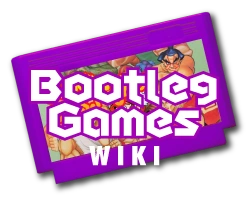Crazy Kong (クレイジーコング) is a clone of Nintendo's Donkey Kong published by Falcon in 1981. While it was an officially licensed clone intended for Japan only, it has been distributed elsewhere in other parts of the world without a license from Nintendo.
Overview[]

Gameplay.
This game is mostly identical to the original Donkey Kong. The game runs on modified Crazy Climber hardware (Nichibutsu).[1] The sample when you jump is the voice of the gorilla in Crazy Climber. The palette is also notably different from the original game as well. Also, there are other versions of the game that run on Scramble, Jeutel, Orca, and Alca hardware.
The game's version is based on a very early Japanese version of Donkey Kong. When each round starts, the text reads "HOW HIGH CAN YOU TRY" instead of "HOW HIGH CAN YOU GET?" The color of the girders are green instead of magenta, Mario's colors are also changed, and the glitch in 25m works as well. The game can also enter 12 characters on the High Score Table instead of 3 like usual. All mentions of Nintendo and even Ikegami Tsuchinki (who is only mentioned through a hidden message and logo) have been removed.
The PCB of the game was not as complicated as the original Donkey Kong's PCB so it was easier to understand and a lot of unofficial copies of the game were made as well. Some of these go by the names Big Kong, Monkey Kong, and Monkey Donkey.
History[]
Shouei, a parent company of Falcon, got permission from Nintendo to release a Donkey Kong clone for Japan. Shouei ended up giving the rights to release the game to Falcon and a company known as Kyouei produced the boards. [2] There is a rumor that UPL helped the conversion of this game, but Ryuichi Nishizawa denied that this happened. [3]
However, versions of Crazy Kong were starting to be distributed elsewhere; notably by Jeutel in France, Zaccaria in Italy, Alca in the United Kingdom, Orca in Japan, and Elcon Industries, Inc. in the United States. Due to Nintendo of America moving locations, there was a delay in the production of Donkey Kong cabinets and, as a result of high demand, Crazy Kong machines started to get imported. [4] However, Nintendo of America took notice, sued Elcon Industries, Inc. in 1982, and won. [5]
Crazy Kong Part II[]
Crazy Kong Part II (クレイジーコング PART II) is an update to Crazy Kong published by Falcon in 1981.
Overview[]
The game is essentially the same with few differences:
- During attract mode, a scene is shown where Crazy Kong is breaking out of a jail/zoo along with a rudimentary one channel audio tune.
- Most of the steel girders have been switched from a green color to an orange/red color, including the title screen.
- After completing the 100m mark, the text "GIVE UP!!" appears.
- During round 2 and on (when L=02), gaps appear in the girders of the 25m mark (the sloped level).
- In the 25m level, some slopes are cut off so that they no longer go down past the ladder.
- Unlike the original Crazy Kong, Mario has accurate/traditional colors.
Trivia[]
- Supposedly, Shigeru Miyamoto saw the intro to Crazy Kong Part II and was impressed, admitting that he thought "They've done it!" after seeing it.[2]
- Falcon would later produce Crazy Junior, a clone of Nintendo's Donkey Kong Jr. released in 1983. However, this was without a license from Nintendo and Nintendo would file a criminal complaint, causing the president of Falcon to get arrested.[2]
- This is the first known arrest for producing unauthorized copies of a game in Japan.
- Despite the differences in Donkey Kong and Donkey Kong Jr., the marquee for Crazy Junior is almost the same as in Crazy Kong, just with a different title, instructions, and Mario sporting different colors. [6]
- Falcon also produced two other games: Royal Mahjong, a mahjong game, and Silver Land, a re-themed clone of River Patrol.[7][8]
Gallery[]
- Main article: Crazy Kong/gallery
References[]
- ↑ https://web.archive.org/web/20180908111030/http://www.geocities.co.jp/SiliconValley/9949/0007.html
- ↑ 2.0 2.1 2.2 https://ja.wikipedia.org/wiki/%E3%83%89%E3%83%B3%E3%82%AD%E3%83%BC%E3%82%B3%E3%83%B3%E3%82%B0#.E3.82.AF.E3.83.AC.E3.82.A4.E3.82.B8.E3.83.BC.E3.82.B3.E3.83.B3.E3.82.B0
- ↑ http://d.hatena.ne.jp/hally/20041104
- ↑ http://wiccy.net/games/crazykongp2.html
- ↑ https://scholar.google.com/scholar_case?case=14413211357527714092&q=564+F.+Supp.+937&hl=en&as_sdt=2,5
- ↑ https://forums.arcade-museum.com/showthread.php?t=404907
- ↑ https://www.arcade-museum.com/game_detail.php?game_id=9374
- ↑ https://www.arcade-museum.com/game_detail.php?game_id=9547
| This page uses Creative Commons Licensed content from Wikipedia (view authors). |
